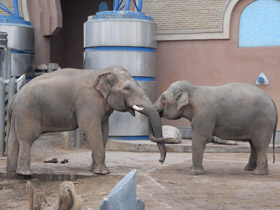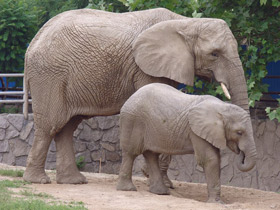Elephants
Why do elephants evoke a sense of fascination in people and what are the things that make these animals unique? Well first, they are huge. Elephants are the largest terrestrial animals in the world and can reach a length of 4 meters, weight of up to 7,000 kg, and body length of 7.5 m. Second, elephants have very peculiar appearance; they feature a massive body, pillar-like legs, and very large head with a long trunk, fan-shaped ears, and small intelligent eyes. It is not possible to forget this creature once you have seen it! Even little kids immediately recognize the elephant at the zoo, if even they only saw a picture of it before.
Probably, the most essential feature of the elephant is its amazing trunk. Many people think that it is just an elongated nose but in fact, an elephant trunk is an extended nose that is fused with the muscular top lip. But why do elephants need their weird trunks? The stature of their body does not allow these animals to lower their head to the ground while standing and they are not able to browse similar to cows and horses. It is possible that elephant trunk developed as a product of evolution, adapted to foraging. The trunk consists of 40,000 muscles and is extremely flexible and strong. The trunk is very important for the elephants – probably, more important than a hand for a human. Elephants use their trunks for tearing leaves and branches from trees, carrying heavy logs, and even picking up tiny objects from the ground, such as a matchstick or a coin (for doing it elephants use special finger-like growths that they have on the end of their trunks; the African elephant has a two-tipped trunk, while the Asian elephant’s trunk has one tip). Elephants are able to use their trunks as water pumps: an adult elephant can soak in up to a bucket of water into its nostrils and then blow the water into its mouth or use it for refreshing shower. Elephants also use their trunks for producing various sounds and communicate with each other; besides, the trunk can serve as a punching or thrusting weapon. When an elephant is going to strike its enemy, it curls its trunk to protect most vulnerable areas. An elephant’s trunk is so strong it can kill an adult human.
Elephants mostly feed on raw fibrous plant food such as grass, leaves, and bark. Their intestine contains special bacteria aiding in the fermentation of cellulose but yet, the elephant is able to digest less than a half of the consumed food and that is why an adult elephant needs to eat 150 to 300 kg of food every day and spend 15 or 16 hours on foraging. Food is grinded by a pair of very large molars. In elephants, the teeth are developed from the back and push forward. As a tooth wears out through grinding, another pushes forward to replace it. Elephants have six sets of molars in their lifetime, with teeth being replaced approximately every ten years.
Elephants do not have canines but their upper jaw features two huge elongated incisors called tusks. The largest African elephant’s tusk ever registered had a length of 3.5 meters and weighed 107 kg. Elephants use their tusks for digging ground, stripping bark from trees, breaking thick branches, and even tearing down trees.
Elephant feet are unique and very interesting. The elephant toes have strong wide toenails and the sole of an elephant’s foot is made of a tough ridged connective tissue which acts like a spongy shock absorber and allows the elephant to move silently and not get sunk in the mud.
Elephants have very thick, almost hairless skin that lacks sweat and oil glands, therefore elephant skin requires a special care. Elephants may spend hours wallowing in mud and then they would put sand or dust on their bodies. Mud dries quickly under the sun and protects the skin of the animals from insect bites and sunburns.
Elephants usually live in family groups headed by an older female. Males stay separately most of the year, occasionally joining family groups. The gestation in elephants is very long (20-22 months). The female gives birth to a single calf weighing about 100 kg. Unlike adult animals, newborn calves are covered with longish hairs. The baby elephant is able to stand and follow its mother soon after birth but it will need to be cared for during long time. At first, little elephants can not control their trunk; they drink water and milk, using only their mouth. The mother suckles her baby for over three years and looks after it till the age of up to 15 years. Young elephants reach puberty at about 14 or 15 years; at that age the males leave their family herd, while young females stay with their mothers and help them to raise their younger sisters and brothers. Elephant breeding and growth rates are very low; an elephant female may give birth only to 5-10 babies during her life.
There are two extant species of elephants on Earth: Asian (or Indian) and African. Asian elephants are distributed in the south of Southeast Asia, while African elephants range across most of the African continent to the south of the Sahara. (Unfortunately, once-continuous ranges of the elephants are now dramatically fragmented.) It is easy to tell apart these two species of elephants. The Asian elephant is smaller and has smaller ears than its African cousin; besides, only bulls of the African elephant have tusks. These two species live in different habitats: Asian elephants mostly inhabit forested areas, while African elephants range in savannahs where the climate is much hotter. That is why elephants need their large ears! Elephants’ ears act as cooling mechanism because they contain extensive network of blood vessels and warm blood cools as it circulates through the vessels in the ears. Elephants often flap their ears to intensify cooling process.
The long history of human-elephant interaction has been very dramatic. In ancient times, elephants were adored and worshiped by humans. In the 17th century BC the Egyptians already knew about elephants. In Asia elephants were used as instruments of war. Hannibal brought in African elephants with the army in his war campaign against Rome. Over five thousand years ago the Indians domesticated elephants for carrying loads, moving logs, transporting heavy burdens, and hunting. Unfortunately, as long as human history remembers, people always valued not just the elephants but also their tusks (called “elephant ivory”). Hunting for elephant ivory in Asia and Africa resulted in deaths of many thousands of elephants. Elephant poaching is happening even in our times: the estimated death toll ranges between 30,000 and 50,000 elephants per year. Elephants are also killed in the large game hunts. The result is tragic: elephant populations are declining and both African and Asian elephants are included in the IUCN Red List of Threatened Species. Elephants may become extinct, if people do not change their attitudes towards these beautiful creatures.

















































